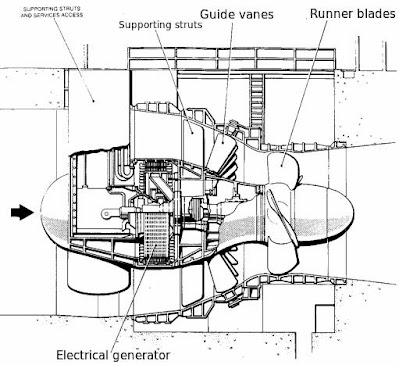The bulb turbine is a hydraulic turbine employed in river and tidal power schemes, where a low head of water is available, for the generation of AC electricity. It is a type of tubular turbine and its efficiency is similar to the Kaplan machine. The name derives from the bulb-shaped structure in the water path containing the electrical generator. Usually, this ‘bulb’ is installed upstream of the turbine as it is supported in the water path by struts. Guide vanes, which are sometimes called ‘wicket gates’, are fitted in the annulus between the bulb and casing to control the flow of water to the runner.
In a bulb turbine, variable guide vanes and runner blades combination provides the maximum efficiency over the load range. It also allow for useful variant for the tidal power schemes. Aside from operating as a turbine in either the ebb and flow direction, there is the capability to pump in either direction to improve the head available for the next generation cycle.
There are two major disadvantage of the bulb turbine: 1) maintenance of the generator is hindered by the limited space and access available within the bulb; 2) the low inertia of the rotating parts means that in some generating networks, there could be some problems, such as synchronizing speed and frequency fluctuations. This is why engineers designed the tube turbine, putting the generator outside the water path as it driven by the turbine through an extended shaft.
Below, a diagram of a bulb turbine, with its important parts.



